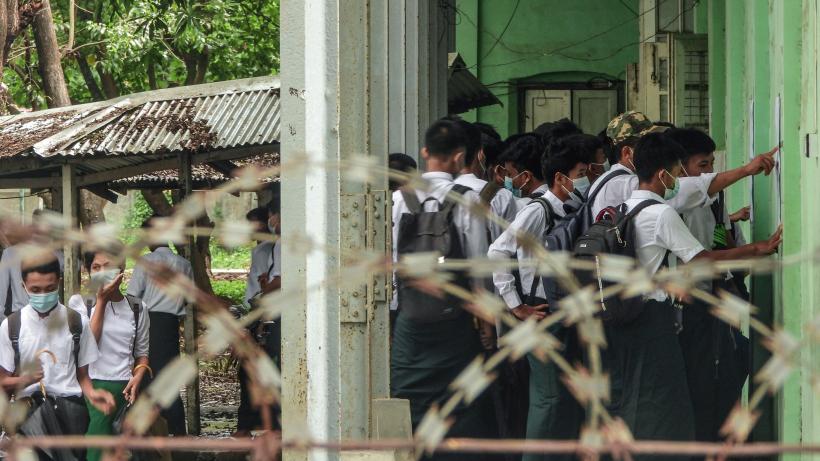
Learning losses in Myanmar: Costs to children beyond COVID-19
While official data remain hard to come by, phone surveys suggest many children in Myanmar remain out of school. Learning losses are most pronounced among children from low-income, low-education, or marginalised households.
Myanmar’s education sector has faced disruptions due to both the COVID-19 pandemic and the 2021 military coup. Between February 2020 and February 2022, public schools in Myanmar were closed for a staggering 532 days, making it the country with the longest school closures in the East Asia and Pacific (EAP) region. After assuming power, the military authorities directed the reopening of public schools in November 2021. However, nearly 30 percent of the teaching workforce joined the civil disobedience movement (CDM) and were dismissed by the military authorities. Many children may have lost more than three and a half years of education. However, obtaining accurate data on enrollment and learning outcomes has been difficult due to suspension of official data collection activities, which exacerbates the difficulty of understanding of the crisis’s depth.
In 2022-23, the World Bank conducted a phone survey of 8,500 households covering 306 of the 330 townships in Myanmar to help bridge this data gap (see Sinha Roy, 2023 for details). Additionally, drawing from international experience (such as Angrist et al., 2020; Crawfurd et al, 2021; Radhakrishnan et. Al, 2021) an innovative phone-based learning assessment was used to evaluate learning levels in the country. Key findings from this study, Bhatta et al., (2023), are discussed below.
School dropout rates surged
Following the Covid-19 pandemic, many countries experienced significant recoveries in school enrollment rates. Myanmar stands in sharp contrast, with the share of 6- to 22-year-olds enrolled in schools and tertiary institutions declining from 69.2 percent in 2017 to 56.8 percent in 2023 (Figure 1). The steepest decline was among high school aged students. Rural and urban children in this age group experienced a decline in enrolments of 17 and 31 percentage points respectively. Financial constraints of households also played a significant role, with enrollment among poorer households declining by 23 percentage points, compared to a 9-percentage points among richer households.
Reasons for dropping out changed over time (Figure 2). Before 2018, affordability was a key reason for leaving school, whereas during the pandemic, 35 percent cited school closures. After the coup, there has been an 8-percentage point rise in the share of respondents citing financial hardship as a reason – reflecting a growing crisis in labor markets and household wellbeing (as reviewed in this World Bank report by Sinha Roy, Demarchi and Rhoads, 2023). Additionally, the proportion of households not providing any specific reasons for dropping out of school has risen by 9 percentage points. This reluctance to discuss education-related topics during interviews may reflect the prevailing security risks affecting the sector amidst the ongoing conflicts.
Figure 1: School enrollment and attendance
Notes: School enrolment and attendance rates have declined sharply, with the share of 6- to 22-year-olds enrolled declining from 69.2% in 2017 to 56.8% in 2023
Figure 2: Reasons for dropping out
Notes: While the share of respondents saying they dropped out due to school closures has reduced after the pandemic, a larger share has reported economic difficulties, and nearly half report ‘other reasons’, reflecting hesitancy to discuss education-related topics.
Remedial measures are scarce for vulnerable dropouts
In theory, non-state schools in Myanmar could have absorbed some of the shocks to public schools caused by the pandemic and coup. However, in practice, only the economically privileged households have been able to access non-state schools as a coping mechanism. The percentage of children attending non-state schools increased from 5 percent in 2017 to 8 percent in 2023, with this change attributed to the wealthiest 60 percent of households. Furthermore, the surge in private schooling is primarily concentrated in urban areas.
Other remedial measures for accessing education include online education and parental support at home. However, our study reveals that only 4.1 percent of children aged 6 to 17 accessed online resources, despite a significant percentage of households owning a mobile phone in the country. Further, enrolled students are twice as likely to use online education compared to those who have dropped out, making it more of a supplementary than a remedial learning resource in Myanmar.
The same applies to parental support at home. Children from wealthier backgrounds were more likely to receive family support and guidance for their education than children from poorer backgrounds, possibly in part due to high income losses sustained in the country. Parental support is also found to serve as a supplement rather than a substitute for regular schooling.
Learning outcomes are waning, risking a generational loss in human capital
Limited measures to address learning deficits are reflected in disparities in learning outcomes between students and school dropouts (Figure 3). The gap in learning levels between these two groups has widened at higher age groups. Additionally, poorer children and children from less educated households are experiencing lower learning levels compared to those from wealthier and more educated families. This is to be expected as dropout rates are observed to be higher among vulnerable households.
Interestingly, there are no significant proficiency differences between state school children and non-state school children, as well as between children accessing other alternative education options (online schooling or learning with parental support) and those who are not. More work is needed to better understand why that is the case.
Figure 3: Proficiency levels among children in school and those that have dropped out
Notes: Proficiency levels among children (ages 8-14) that have dropped out of school are lower than among children enrolled in school
The combination of high school dropout rates, limited opportunities to cope with loss of learning and low effectiveness of remedial measures indicate a massive and growing crisis in Myanmar’s education sector. Unaddressed, this could risk a generational loss of human capital in Myanmar.
A version of this article first appeared on World Bank.

